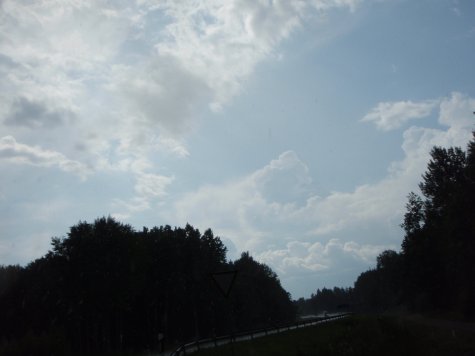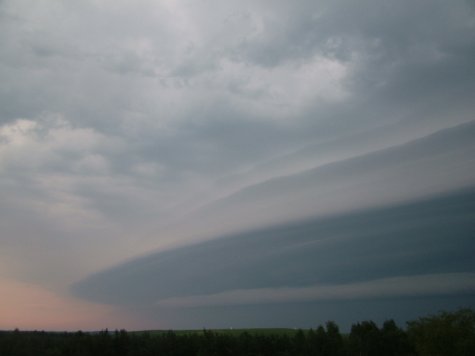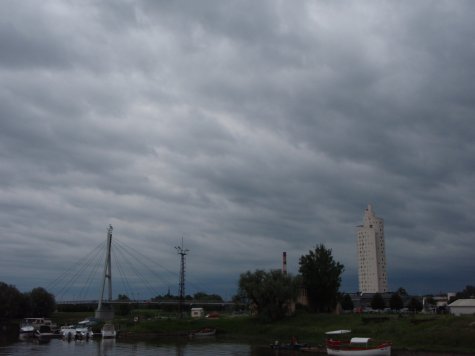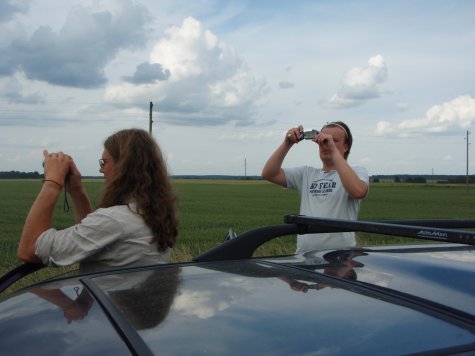Baltic weather chasers
Text, photos and interview by Jüri Kamenik
Translation: Liis
I have been fascinated by violent atmospheric events ever since I was small; I remember that already in kindergarten the teachers sometimes when there was storm or lightning brought us to the window and explained what was happening. Probably that was one thing that started my interest.
With time the centre of my interest came to be thunderstorms and their associated clouds. I have observed most of the thunderstorms from our summer house in Laitse, stationarily, that is, I haven’t had a chance to go chasing the thunder. My oldest memories of great thunder episodes are from 1996-1998, from the summer house as well as from Tallinn.
In 1998 something more happened that deepened my interest, this time not for thunder or storms but for weather in general. That winter when I was in the 3rd form our biology teacher asked the whole class to make weather observations for a whole week. That taught me to note weather phenomena and their changes quite carefully and so I began to take more interest in other aspects of weather too. As a curious coincidence at nearly the same time, maybe a month or one and a half later, on the suggestion of another teacher we started to use the Tähekene in our Estonian language lessons: little stories and plays aimed at children were published in it. They were very suitable for use in the lessons. But the important thing was that in the first Tähekene that I saw was a story about clouds and thunder on the back cover, and very powerful photos too. I wondered if it could maybe be bought in some shop or stall but sadly it was not to be had any longer anywhere, I could only study it in libraries
This event too helped to develop my interest.
When observing distant thunderstorms stationarily over the years I have all the time been thinking of how to get closer somehow. I remember a very far-off occasion from the summer house, it may have been around the year 2000: the morning was warm and very humid, but towards midday it turned clearer. The sky was cleared of clouds, but in the south-eastern part a rather large cloud chunk remained that seemed not to move at all. A constant thunder was audible from it, thus it was barely 40-50 km off. It went on for hours and I was not the only one to watch it. Then I was really gripped by a very strong feeling that one should go and catch the anvil of this thunder.
At that time I didn’t think particularly of recording, because I had really no photo equipment or a computer. The latter I only got in 2004, and a digital camera in 2007, but I still started photographing particularly exciting and photogenic clouds already in the summer of 2003. I selected the moments for photographing very carefully because I always had in mind the fact that the number of exposures on the film roll was limited and it all cost money, and moreover other family members wanted to photograph too. But when there was a phenomenon that many people at the same time were looking at or if I saw someone staring at a cloud or the like, mouth wide open, then I counted it as a sufficient reason to take a photo.
So I did too if what I saw made an exceptional impression on me. So I made about a dozen photos in some months and then the camera showed that now the roll was full. I started to take it out when it became clear that there was no film in the camera! It was a terrible shock and not until the summer of 2004 I started to photograph in the same way again, and this time I checked that I was not making empty exposures.
I took the photo above on 7.9.2004. It was a very unusual day, because it was stormy, shiver-producingly cold and with heavy thunder episodes – a really exceptional combination. The thunders got loose after noon when the wind had reached its most outrageous turns so that it could already fell smaller trees. In the evening, it may have been around 18 o’clock, a series of clouds appeared in the western sky that I photographed. Below this a continuous series of lightning flashes started and at the peak moment there was at least one flash every second. The storm moved straight across us and brought along hail lumps up to fist-size. People in the streets screamed in panic and fled in all directions. The storm passed in about 15 minutes and the whole of the remaining evening was sunny. Roughly at the same time a very large waterspout was observed above the Gulf of Finland, see http://www.ilm.ee/index.php?41444 and a Nõmme inhabitant photographed the fallen hail, they were much smaller than those fallen at Laitse but impressive all the same, see http://www.ilm.ee/index.php?3985.
I arrived at systematic photographing of weather only in 2007. One more year later I took a step nearer thunder-chasing: on July 14th 2008 exceptionally dangerous weather conditions were forecast for South Estonia as well as heavy thunder. So I went to Tartu especially to observe events at closer quarters. The wait dragged on because during several hours nothing happened. Only at 16 o’clock the western sky turned darker and the thunder arrived:
The thunder was not so bad however, but much rain fell and the sky was exceptionally dark. It was particularly dark towards south. Later it did become clear that the heaviest thunder had been towards Põlva, with floods. The torrential rain was brought along by a southerly cyclone that moved towards Russia.
I got on real thunder hunts only in June 2009. On June 13th I made a test chase and a little later, i e about Midsummer, already proper chases. I didn’t succeed in coming across anything extraordinary but I did get an idea of how it might be done. July 1-2, 2009 was very instructive in this regard because then I took two other aficionados on board and we planned to go from Tallinn by way of South Estonia to Kaliningrad where exceptionally high indicators of atmospheric lability were expected and the potential of an extremely heavy thunderstorm thus was extremely high.
On the morning of July 1st we started our trip and moved by way of Kilingi - Nõmme and the Ikla border point towards Riga; on the roundabout we at first went in the Vilnius direction where we did not want to go, turned round, and after that headed straight south to the Lithuanian border. There were cumulus clouds in the sky and at the Lithuanian border already cumulonimbus clouds too, but nothing promised anything much. In the west the sky was quite dark and there was some sort of convective activity to be seen. Finally we reached Liepaja and from there we went back on the Riga circle. We did not see any thunder but got an idea of the bad Latvian roads. We reached the roundabout when it was already dark and then we saw lightning flashes above the Livonian Bay. We drove to the shore, observed it for some time and started on the road back to Tartu. Since we hade driven more than 1000 km and the trip had lasted more than 20 hours we had to sleep towards morning in the interest of safety. In early morning we continued the journey and somehow dragged ourselves to Tartu. After that we separated, I slept until 14 o’clock and feeling that now I was rested, happened to look at the sky. Quickly, without losing any time, I rushed to the car and drove to north of Tartu to capture the developing thunderstorms. I did manage to catch them and chased the thunderhead that had formed until Võru, whereupon I went back to Tallinn.
All things considered I count this mammoth chase as a failure because although we finally saw the thunderstorm we drove most of the time emptily and aimlessly. We did not even have the option to look at a radar or satellite image and so we had to observe the clouds continuously. The cause of the failure was of course little experience. It also caused several potentially dangerous traffic situations i a driving when very tired which must be avoided at all costs.
I am still amazed that on the nearly 2000 km journey (including the folllow-up chase) no accidents occurred. This trip showed clearly that in weather chasing there are necessary, even primary safety rules, just rushing about and chasing is only a danger to oneself and others.
The two aficionados who were with me on 1.-2.7.2009 photographing convection clouds at the Latvian border.
 July 2nd north of Tartu. The developing thunderhead is visible; a shower with large drops is falling.
July 2nd north of Tartu. The developing thunderhead is visible; a shower with large drops is falling.
In 2009 I made some ten successful chases with other interested parties, some of them in Latvia. In 2010 I continued the weather chasing but mostly on my own because I grew interested in a more precise study of the growth of clouds and storms and how chasing should be done best and to the point and what safety rules to keep. In 2011 independent chasing went on but then another interested party came up who lives in the Rakvere area and who had been chasing storms in the same way lately. One day in June in 2011 he even called me about chasing a storm together but the distance was huge at the time and there was nothing worth seeing in my opinion. With time I have realised that every little cloud is not worth chasing, but always only the largest or most intense thunderheads where there is something to see and study.
He took a great step forward from the Estonian point of view in the development of weather chasing in creating the presently successfully operating association for similarly minded people. He calls himself Estonian Stormchaser and here follows a short interview:
1) Estonian Stormchasers (ESC in the interview), who are you, and what are your aims?
Estonian Stormchasers:We are seriously interested in weather. Our interest is to follow the weather charts and be in touch with changes in weather in Estonia as well as elsewhere in the world. Primarily we follow the movements of storms, cyclones here as well as elsewhere. ESC is also interested in being in place at more complicated weather situations and to make observations in the area.
2) How did this idea come about at all? There can’t be many who would be seriously interested in such a thing ...
Estonian Stormchasers: The idea came from the fact that I have already since early childhood been fascinated by heavy rain, strong lightning, thunder, snowstorms, high waves, storm winds.... In short, everything where nature shows that man is only a very very small creature in this world. When the subject started to be a serious interest I also checked if there were other interested parties. And it became clear that there were such people elsewhere in the world and in Estonia too. Not very many but enough to give rise to common thoughts and themes to discuss.
3) When did you start the activities and what were the early activities like?
Estonian Stormchasers: The name ESC was born sometime in the beginning of 2011. The main idea and reason why such an association was created was that since the majority of the so-called "storm chasers" are individual doers, in a joint activity information might be shared faster and so more interesting results would be produced, also that the information that we collect is surely interesting to read and study for others with similar interests. At the moment we are busy with developing joint activities. Broadly speaking each „ESC“ member still acts on his own and when he has found some information on a storm chase it is shared with others. At the moment we also develop a Skype info list, where it would be possible to exchange information rapidly online and maybe even see direct transmissions in "live streams" straight from where it happens. What a live stream is can be read here: http://new.livestream.com/broadcast-live/get-started, and about its application for thunder and other chases see http://www.chasertv.com/.
4) At what stage are you now? what are you doing at the moment?Estonian Stormchasers: Since most of us are working people and students our everyday life is about following the weather charts. Since the Estonian climate is rather mild, generally speaking, we also follow what happens elsewhere in the world and share the info between us. In everyday life the relations go by way of the earlier mentioned Skype "conversations".
 A thunder king (the dream of every thunder chaser) arriving to Tallinn in early morning on 26.7.2010.
A thunder king (the dream of every thunder chaser) arriving to Tallinn in early morning on 26.7.2010.
5) What are your plans for the coming summer?
Estonian Stormchasers: A strong aim is to raise the number of our membership particularly in different areas of Estonia. Behind this aim is precisely the fact that when something is happening or shaping somewhere it would be possible to get operative info from the current area. The second aim would be to arrange common well-coordinated storm chases. We would also like to test "livestream" straight from the action area together with Skype´s online exchange.
6) Where can we find you? How can we make contact?
Estonian Stormchasers:We can be found in Facebook, by the name "estonian.stormchasers". When you have found the name, we should be added to your list of friends. Our e-mail address is eestitorm@gmail.com and the Skype info list/conversation at the address estonian.stormchasers. Be sure to add a brief presentation of yourself on joining by Skype.
7) How are or might the chases be in reality?
Estonian Stormchasers:On the basis of information collected in advance we head for the area where the thunderhead or anvil is developing. If the chase is with several motors we divide the directions, who follows what. Info is exchanged by way of mobile (in a future perspective we of course think in terms of online radio connections). In thunderchasing getting info is vital – to know where to head. With thunder clouds it is known that the clouds don’t necessarily move with the wind. The directions of the whole system need to be known.
A cut from a demonstration chase can be seen here (26.7.2011 in the Haljala area): http://www.facebook.com/photo.php?v=124224594337488
8) Do you cooperate with others? Whom?
Estonian Stormchasers:At the moment the majority of the "ESC" members act on their own. All with their own techniques and apparatus. In a longer perspective we have also considered recruiting enterprises and representatives of enterprises in cooperation with whom the info collected in storm chases might be useful and interesting to many Estonians (forecasting work and operative information to avoid storm damage and other themes; for instance in the USA information from "Storm chasers" is used in prognosis work and in avoiding imminent storm damage.
The full length interview can be read here:
Earlier in the newspapers on the same theme:
From 2005 a thunder observers’ network has led by Sven-Erik Enno been active in Estonia:
In Finland active thunder chasers and other interested parties operate already since years: http://www.myrskyvaroitus.com/site/index.php?option=com_content&task=view&id=36&Itemid=50
Useful information on clouds and thunder can also be found at:
Anyone who would like to follow storms and thunderstorms elsewhere in Europe in real time (armchair chasing) can find a selection of web cameras here: http://www4.wetterspiegel.de/stormchaser/livestream/?page=webcam
Weather chasing according to safety rules and responsibly: http://www.cimms.ou.edu/~doswell/Chasing2.html
A narrative of thunder chasing can be read here (in Estonian, but with many photos):
(Estonian original of the article published on June 25th, 2012)

.preview.jpg)









